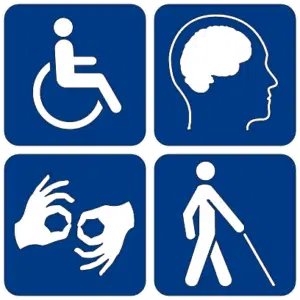A Brief History of the Americans with Disabilities Act
January 4, 2016
Accessibility is an important aspect of those who have disabilities. The Americans with Disabilities Act of 1990 is a crucial law put in place that has allowed equal opportunity for a wide range of disabilities, both mental and physical. There is not one person to thank for the law, but rather the thousands of individuals who fought and raised awareness for years on the importance of accessibility and non-discrimination towards people with disabilities.

A great amount of work and effort on the parts of these individuals educated the public and politicians, ultimately leading to the signing of the law on July 26, 1990. Here is a brief history of the Americans with Disabilities Act and the importance of its regulations.
Behind the Disability Rights Movement
The Americans with Disabilities Act has been in place for more than 25 years. Many years prior to George H. Bush signing the act into law, people with disabilities and parents of children with disabilities began challenging the social barriers that kept them from being a part of their communities. Handicap accessibility was rare and discriminatory policies were common among businesses. Citizens with disabilities began raising awareness about these unjust practices to the public in order to fight for a common cause for both physical and mental disabilities. This was known as the Disability Rights Movement, meant to achieve equal opportunities for those with disabilities. The movement began in the 1960s and focused on accessibility and safety, especially for means of transportation.
Prior to the signing of the ADA, people accepted discrimination and inaccessibility as unavoidable consequences of having a mental or physical disability. Much of what the Americans with Disabilities Act regulated was a basis of Section 504 from the 1973 Rehabilitation Act, which outlined concepts of non-discrimination for those with disabilities. The ADA, however, established more regulations concerning accessible design and inclusion.
The Importance of the ADA
The Americans with Disabilities Act is ultimately a wide-range civil rights law to protect against any discrimination based on disability as well as guarantee accessibility and accommodations. This also included reasonable accommodations for employees with disabilities. It requires accessibility for all public accommodations, such as accessible entry ways, accessible transportation methods, and accessible public facilities. For example, all public accommodations such as hotels and lodges, correctional facilities, stores, public recreation centers, and public parks, must have handicap accessible parking, entryways, and many other ADA compliant features to meet current standards. These standards are kept in place to ensure inclusion and allow equal opportunity for everyone.
Beginning in 1992, the law stated that any new construction must be complaint with ADA regulations, which meant a growing number in accessible designs, including curb ramps, accessible routes, and communication elements and features. To ensure that owners of public accommodations comply with current ADA standards, there are substantial monetary fines in place.
The ADA and Pool Lifts
As the government continues to review and update these regulations, new ADA guidelines become available. In 2010, a new set of standards for accessible design became available to the public, which included accessibility requirements for swimming pools, wading pools, and spas. These revised requirements were issued in order to provide accessibility when entering and exiting a pool or a spa.
Pool lifts have been a method of accessibility for years since the 1980s, and have gradually progressed in design over time. Today, they must comply with current ADA regulations. The 2010 Standards require any new constructed or altered pools to have a means of accessibility, which also includes specific requirements for pool lifts: location, seat size, lifting capacity, and floor space.
Pool lifts are only one example of accessible design when it comes to handicap accessibility. Like many other accessible means, they provide inclusion and equal opportunity for everyone.
